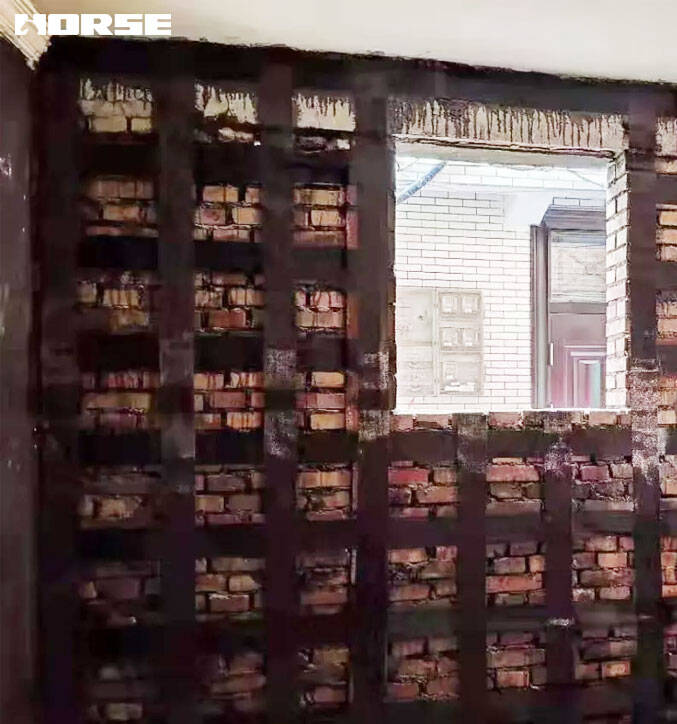Solutions
Horse Construction offers full range of structural strengthening materials with technical supports, documentation supports, products supports, project supports.
reinforced masonry structure
This article introduces the principles and methods of using carbon fiber composite materials to reinforce masonry, hoping to solve the plight of practitioners to a certain extent and provide new ideas.
The masonry structure has been widely used in multi-story houses, schools, hospitals, scientific research buildings and other buildings because of its advantages such as investment savings, convenient construction and local materials.
However, the masonry structure also has shortcomings such as low tensile and shear strength. Many masonry structures have cracks of different degrees and different forms during construction and use.
1. Basic concepts:
A structural reinforcement method that uses structural adhesives to paste the fiber composite material on the surface of the wall and jointly bear the force to improve its shear bearing capacity.
2. Application:
It is suitable for shear reinforcement and seismic reinforcement in the plane of sintered ordinary brick walls. The reinforced brick wall shall be free from cracking, corrosion and aging. The measured brick strength level shall not be lower than MU7.5, and the mortar strength level shall not be lower than M2.5.
3. Advantages and disadvantages:
(1) Advantages: the construction is simple, and the weight of the original components is basically not increased after reinforcement, and the shape of the structure is not affected.
(2) Disadvantages: the durability and fire resistance of the adhesive, and the anchoring of the fiber composite material.

4. General provisions
(1) When the externally bonded fiber composite material reinforces the brick wall, the fiber stress mode should be designed to withstand only the tensile stress.
(2)The fiber composite material pasted on the surface of the brickwork should be protected. Surface protective materials should be harmless to fibers and adhesives.
(3)For the brick wall structure strengthened by this method, the ambient temperature for long-term use should not be higher than 60 ℃. When the brick structure in a special environment is reinforced by this method, an adhesive that is resistant to environmental factors should still be used, and the construction should be in accordance with the specific process requirements.
5. Construction requirements
(1)When the shear bearing capacity in the plane of the masonry wall is increased, the methods of horizontal paste, cross paste, flat fork paste or double fork paste can be selected according to the actual project. Vertical or horizontal beading should be applied to the end of each method.
(2)The fiber cloth strips should be evenly arranged on the entire wall at equal intervals. The width of the strip should not be less than 100mm, the maximum net spacing of the strip should not be greater than the height of the three skin bricks, nor should it be greater than 200mm, and there should be reliable anchoring measures along the direction of the strip.
(3)The anchoring structure measures of the end of the fiber cloth strip can be pressed firmly according to the condition of the end of the wall. When the strip needs to bypass the positive corner, the radius of curvature at the corner of the positive corner should not be less than 20mm.
(4)When the long fiber cloth strips are connected by the lap method, the lap length should not be less than 200mm, and an anchor bolt should be set in the middle of the lap length.
(5)Construction points: The surface of the reinforced wall should be covered with cement mortar first, the thickness is greater than or equal to 15mm and should be smooth, and the strength level of cement mortar is greater than or equal to M10. Pasting the fiber composite material should be done after the smoothing layer is hardened and dried.
You can find anything here you are in need of, have a trust trying on these products, you will find the big difference after that.

High strength, unidirectional carbon fiber wrap pre-saturated to form a carbon fiber reinforced polymer (CFRP) wrap used to strengthen structural concrete elements.

High strength, unidirectional carbon fiber fabric pre-saturated to form a carbon fiber reinforced polymer (CFRP) fabric used to strengthen structural concrete elements.

High strength, unidirectional carbon fiber sheet pre-saturated to form a carbon fiber reinforced polymer (CFRP) sheet used to strengthen structural concrete elements.